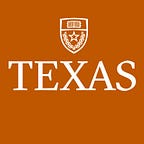Andy Ellington: Instead of Nuts and Bolts this Robot is Made from DNA
The Ellington Lab at UT Austin engineers artificial life, including nucleic acid operating systems.
Andy Ellington is a professor of molecular biosciences in the College of Natural Sciences at UT Austin. Ellington and his team at The Ellington Lab are more like engineers than biologists, he says. As biotechonologists they look at DNA as a key building material in the frontier of computational design.
Recently Ellington and two members of his lab, Cheulhee Jung and Peter B. Allen, published a study in the journal Nature Nanotechnology about their design of DNA nanorobots that were able to “walk,” unprogrammed and in different directions, over a DNA-coated surface.
“One day, this kind of DNA robot might be a cancer detector roaming the human body searching for cancerous cells; or perhaps an ingredient in a future meta-material responding to the needs of the body,” said Ellington.
We talked to Ellington about the field of nanotechnology, the future of the DNA walker and his approach to research.
The DNA Walker has been referred to as a nanomachine or nanorobot. How can DNA be a machine?
AE: When most people think of a machine, they think of things moving. Nanotechnology is made by manipulating individual molecules. This process makes it possible to create entirely new materials or machines. The DNA walker is a robot on the nanoscale that moves, and its materials — rather than nuts and bolts — are DNA.
How could doctors use the DNA walker in the future to hunt cancer? Would it work alone or be part of a larger mechanism?
AE: If you can build one robot, you can build a hundred. They can gang together to do tasks, and all of a sudden a nanorobot made from molecules doesn’t seem so silly. They are undertaking coordinated behavior like a swarm of bees. They would traverse the body and find the cancer cell, and they would potentially kill it. That is no longer completely science fiction — you can now imagine DNA nanomachines potentially doing that.
How big is the leap from today’s DNA Walker to this swarm of cancer killing nano-robots?
AE: The DNA Walker is a tiny tiny little step in that direction, but I can’t do this by myself. What needs to happen is somebody needs to come up with the programming language. You can make a computer, but if it sits there without a language it can’t do a whole lot. I make the basic circuitry, but I need the language to program it.
To get to that language I need theorists to work with. One of the great things about UT is we just hired one of the best theorists in this area. David Soloveichik, a computer engineer, and I are going to try and make this leap. I’m the hardware guy and he is the software guy. Between us we hope we can make these advances.
What are the implications for the DNA Walker beyond health?
“There is only one thing on Earth that I know of that can store information in an incredibly complex way without electronics, and it’s called DNA.” -Ellington
AE: Imagine a different type of computer: The kind where the memory elements are molecules and the transactions between the memory elements are things like DNA walkers. Instead of having electrons being the medium of computation, now it’s carbon. What kind of computation can we do with carbon? How is the computation different? Maybe we can make smart materials where within the material things crawl around to help it morph to new forms.
What do you want people to understand about your research with DNA?
AE: There is a fundamental thing that I hope everyone can grasp: Other than the circuit board on your computer, DNA is the only game in town. It’s the only way to store that much information. DNA is the only material — anywhere, anytime — that can be what I like to call a “matter computer.”
“We need to learn not only the secrets of life, but how to program it.” — Ellington
